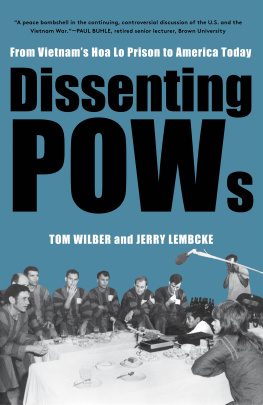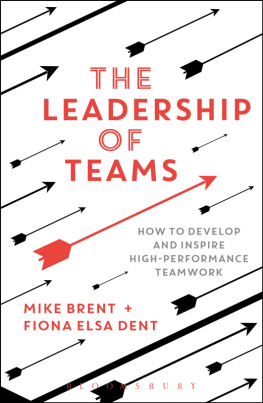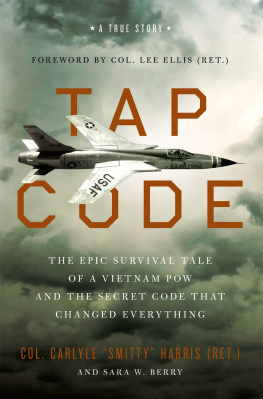LESSONS
FROM THE
HANOI
HILTON
LESSONS
FROM THE
HANOI
HILTON
LESSONS
FROM THE
HANOI
HILTON
SIX CHARACTERISTICS OF
HIGH - PERFORMANCE TEAMS

PETER FRETWELL AND
TAYLOR BALDWIN KILAND
WITH DR. J.P. LONDON
AND DR. JAMES B. STOCKDALE II
NAVAL INSTITUTE PRESS
ANNAPOLIS, MARYLAND
Naval Institute Press
291 Wood Road
Annapolis, MD 21402
2013 by Peter Fretwell and Taylor Baldwin Kiland
All rights reserved. No part of this book may be reproduced or utilized in any form or by any means, electronic or mechanical, including photocopying and recording, or by any information storage and retrieval system, without permission in writing from the publisher.
The quotes by James Stockdale used in the side bars on pages 86 and 111 were reprinted from Thoughts of a Philosophical Fighter Pilot, by James B. Stockdale, with the permission of the publisher, Hoover Institution Press. Copyright 1995 by the Board of Trustees of the Leland Stanford Junior University.
All figures created by Matthew Simmons.
Library of Congress Cataloging-in-Publication Data
Fretwell, Peter.
Lessons from the Hanoi Hilton : six characteristics of high performance teams / Peter Fretwell and Taylor Baldwin Kiland ; with Dr. J. P. London.
pages cm
Includes bibliographical references and index.
ISBN 978-1-61251-218-1 (ebook) 1. Vietnam War, 1961-1975Prisoners and prisons, North Vietnamese. 2. Prisoners of warUnited States. 3. Prisoners of warVietnam. 4. Leadership. 5. Resilience (Personality trait) I. Kiland, Taylor Baldwin, 1966- II. London, J. Phillip, 1937- III. Title.
DS559.4.F74 2013
959.7043dc23
2013001735
21 20 19 18 17 16 15 14 13 9 8 7 6 5 4 3 2 1
First printing
Contents
In this remarkable book Peter Fretwell and Taylor Kiland synthesize the collective experience and wisdom of men whose courage and loyalty is legendary. In younger years, I was honored to spend time surrounded by many of these men. Upon return from prison, they spoke of unity, strength, and a will to prevail in an atmosphere of brutality with an unconscious, clinical detachment that often stunned listeners. Their matter-of-fact delivery heightened the impact of their insights and quietly cut through the trivialities that seemed (then and now) so burdensome in modern life. Their humility was (and is) miraculous. Their continued loyalty to one another and dedication to their beliefs remain as durable as they are timeless.
Those of us who live with them have always sensed that the silent society they createdthe invisible institutionalization of values, guidelines, and devotion to one anothermight serve as a model for any family, group, or alliance that shares common purpose. Their struggle (in the end) might well inform a culture of mutual trust and commitment essential to productivity and healthy communities. Many authors have tried to articulate the lessons that might lead to such a modelbut (with all due respect) the attempts I have read are either too close to the experience or struggle to comprehend its breadth and depth. To be fair, this difficulty is very understandable as the subject matter consists of what classical scholars denote as universals.
Peter Fretwell and Taylor Kiland have interviewed, studied, and examined the narratives and issues of these men with deliberate focus for the last seven years. Their gift to us in this remarkably well-written compendium is the distillation of life lessons for those seeking practical application. They clearly set forth what we can learn from those who created their own civilization. As the authors have winnowed through thousands of pages and sources, they have centered relentlessly on the traits, behaviors, and practices that lead to shaping a high performing team.
In Lessons from the Hanoi Hilton, the authors render a ready guide for the formation and nurturing of teams that perform with fluid motion and what appears to be effortless communication. They elaborate and build on exemplars dedicated to loyalty, honesty, clarity of mission, and values that sustain unity. The authors have, in essence, created a curriculum for study and implementation of these practical concepts that are vital to any organization.
I have long found it ironic that the cynical name Hanoi Hilton clings to the experience of the brave souls who shed their blood within its high, thick double walls. Built by the French and designed to de-humanize its inhabitants with shards of broken champagne bottles serving as provincial razor wire, it stood in the middle of Hanoi. Several North Vietnamese political leaders at the time of the American war had spent time in its cells and leg-irons during the fifties. The complex was a labyrinth constructed to disorient inmates and its actual name was Hoa LoFiery Furnace.
The Furnace, (even with its horrors) might serve as metaphor in retrospect. The isolated, compressed experience of those who survived there was, I submit, a refiners firea deep foundry in which precious metals are brought to searing temperatures over and again until they reach their most pure (and precious) state. So it was with the men of Hoa Lo walking away united and phenomenally refineda gold standard of our countryprecious metal in a world with much too much slag and dross. In many ways, this gem of a book accompanies their excellencean excellence as difficult as it is rare.
Finally, this work praises my father and (in many ways) anoints him as a leader of men. He has been praised in many ways. But the reader should know that during thoughtful days in quiet moments Dad would share his soul with me and otherspouring out his incredible admiration and respect for each man with whom he served during difficult days.
While I hesitate to speak for him, the man I knew and loved would want to allocate any acclaim, fully share any tribute, and thoroughly distribute any glory associated with his contributions. Without the strength and courage of each and every man, his thoughts and words would have been an empty vessel. Dad knew, in the end, that leadership is nothing if not for the willingness of those who follow. He stands among his menmen who returned with honor.
James Bond Stockdale II, PhD
The prisoner of war (POW) experience is unimaginable to most of us. Even more unimaginable is the idea that something positive could come of it. For the Vietnam POWs of the Hanoi Hilton, the possibility of survival rested on finding something positive and developing a culture around it. That positive goal was Return with Honor, and an entire culture was created to unify and motivate the POWs not only to survive the harrowing experience, but to come home with dignity.
It may also surprise some people that many facets of the POW culture are shared by successful individuals and organizations. Its true that as part of the U.S. military, the POWs already belonged to a successful organization with a strong culture. However, as Lessons from the Hanoi Hilton reveals, there were specific values and actions adopted to overcome the Vietnam prisoner of war experience that transcended the military experience.
As a 1959 graduate of the U.S. Naval Academy and a former Navy pilot, I have a very similar background to many of the Hanoi POWsbefore their experience. The most important lessons that I have learned in life have been applicable not only to my military career, but also to my civilian career in government contracting and my personal life.
Next page








